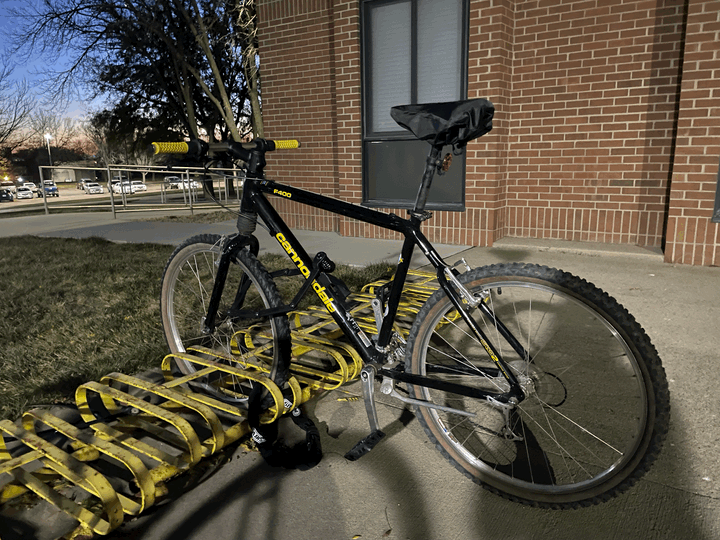Campus safety officer masters unique talent, dubbed ‘batman’ of Augustana

Tucked away in the northeast corner of campus, East Hall sits cozied up to its counterpart, the now-abandoned Old Main. Without the handful of windows that spill light into the darkness at night, any passerby may be inclined to assume East Hall too is home to only dust and cobwebs.
Even on the inside, there are few signs of life. Silence fills the building on a typical weekday night. The dim fluorescent lights illuminate the drab carpet and beige walls in a pale glow. The common rooms lie empty. The washers and dryers in the basement wait patiently.
Silence. The occasional toilet flush.
On what appeared to be a night like any other, the phone in the campus safety office rang. A student in East Hall had come face-to-face with a bat on her way to the water fountain. Grabbing a butterfly net, Brody Reed, a campus safety officer, made his way toward the building to deal with the nuisance.
The job of catching these unwelcome neighbors falls on the shoulders of campus safety officers.
The safety threat of a bat, although small, is hard to prevent; officers must wait for a student to encounter a bat and call it in.
Reed, gloves on, held a butterfly net in his right hand and his baton in the left. He nudged the bat with his baton, countering with the net.
This semester alone, Reed has captured five bats. Most of them, he says, are in East Hall, although he isn’t surprised by the occasional call from Tuve or the chapel.
He has bat-catching down to a science. Reed seems to find it enjoyable, laughing as he remembers a particular student whom he found hiding behind a door from a bat in East Hall’s lobby.
“You just got to hope to hit [the bat],” Reed said about his personal technique. “I found out that when I hit ‘em, it kind of knocks them out a little bit.”
Once the bat is stunned, Reed uses his baton to guide the bat into the net. After it is tucked into the netting, he twists the slack to trap the bat in the net. This maneuver allows him to transport the bat out of the building.
Reed is the campus “batman,” a nickname his fellow officers gave him following the first call he received about a bat on campus. At that time, three years ago, he was a rookie. He made his way over to Tuve with no plan in mind.
Eventually, Reed managed to trap the bat in his butterfly net, but he hadn’t yet discovered that twisting the net stopped the bat from escaping. Naturally, this bat tried to crawl out of the net. Reed used his gloved hand to gently push it back into the net.
Once he was outside, Reed released the bat, but as he returned to the campus safety office and removed his gloves, he noticed something unfortunate. The bat had scratched him.
Less than 24 hours later, Reed found himself at the hospital. In one sitting, he was administered a total of seven rabies shots: four near the scratch site and three others in his arms and legs.
For one month, he completed weekly rounds of rabies shots.
“I became friends with all the nurses on that floor,” Reed said, proving just how often he was at the hospital for rabies treatment.
The campus safety officers may not prioritize catching a bat if they receive a more serious call about a theft, for example; however, bats are not harmless. The officers understand that these animals have the ability to carry rabies.
Because bats are a protected species, killing bats in the residence halls is against the law. They must be caught and released.
According to the City of Sioux Falls website, about 3% of all bats tested for rabies lead to a positive result nationwide.
In 2023, 18 bats tested positive for rabies, the most identified in any year in the past decade. Most of these bats were found in Minnehaha County.
Head of security Rick Tupper is certain students are not at risk of getting rabies at Augustana. There has never been a rabid bat on campus, Tupper said.
Stepping into Tupper’s office, it is clear he takes his job seriously. He answers questions as they come, at ease but always ready to spring up at a moment’s notice.
“Brody and then one, a student, had to go through [rabies shots],” Tupper said, recollecting his 20 years of experience at Augustana.
The University has brought an official “bat-man” to campus before. The bat-man’s job, Tupper said, is to gauge how expensive it would be for all crevices and holes to be sealed in a particular building. Old buildings like East Hall are quoted at around $10,000 to effectively seal, Tupper said.
As of now, the university is not willing to spend that amount of money on a defense that may not even work, Tupper said. If even one small crack is left unsealed, bats will continue to make their home in buildings.
The responsibility of catching bats will continue to be that of campus safety.
Tupper said that trainees usually work with an experienced officer for a month before they are allowed to go out on their own, but training as far as bat-catching is almost nonexistent, apart from the toy bat that Tupper uses to scare his officers.
He throws it at them, saying that if they can catch a rubber bat, they can catch a real bat.
Although Tupper is confident that students are safe from the occasional bat on campus, the students who live among them seem wary to agree.
Seniors Alyssa Hasert and Annaliese Wagers, both residents of East Hall, say they are concerned about rabies. Because bat bite marks are small due to their fine, sharp teeth, an individual is often unaware that they have been bitten.
There is no effective treatment for rabies after the infection sets in, according to the Mayo Clinic’s website.
“I’ll hear a weird noise and wonder if it’s a bat,” Wagers said.
“You can hear them in the walls,” Hasert pitched in, her eyes wide.
Wagers and Hasert have both lived elsewhere on campus. As previous residents of Wagoner Hall and Solberg Hall, respectively, they never considered bats to be an issue for them until moving to East Hall.
Wagers noted the biggest problem in Wagoner Hall wasn’t bats, but football parties.
“Honestly, I prefer the bats,” Wagers said, smiling.
Hasert disagreed.



